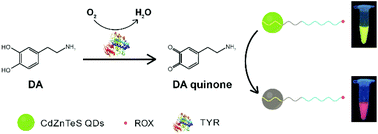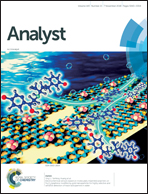Simple construction of ratiometric fluorescent probe for the detection of dopamine and tyrosinase by the naked eye†
Abstract
In this work, a simple and novel ratiometric fluorescence method based on ROX-DNA-functionalized CdZnTeS quantum dots (QDs) was developed for the detection of dopamine (DA) and tyrosinase (TYR). A ratiometric fluorescent probe was constructed by binding phosphorothioate DNA to the metal ions of QDs, which is a modification-free and low-cost method. DA was easily oxidized to DA quinone under the catalysis of TYR by dissolved O2, which effectively quenched the fluorescence of the QDs. Strong linear correlations were achieved for TYR in the range of 10.0–100.0 ng mL−1 and for DA in the range of 10.0–1000.0 nM. The limit of detection was estimated to be as low as 1.05 ng mL−1 for TYR and 1.93 nM for DA. Moreover, various colors were displayed in the course of detection, which could be observed by the naked eye. Therefore, an on-site and sensitive fluorescence method for the visual detection of DA and TYR can be developed. In addition, the findings revealed the potential applicability of the ratiometric fluorescent probe for the detection of DA and TYR in human serum. This ratiometric fluorescence method is not only sensitive and selective but also rapid and convenient for the detection of the analytes without sophisticated instrumentation.



 Please wait while we load your content...
Please wait while we load your content...